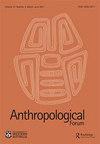Addressing Cultural Difference in Indigenous Copyright Cases
IF 0.7
3区 社会学
Q3 ANTHROPOLOGY
引用次数: 0
Abstract
ABSTRACTThis article presents and discusses two different ways through which the Ganalbingu people (Australia) addressed cultural differences in the normative conceptualisation of artworks in a judicial setting. The analysis focuses on linguistic conduct held by the plaintiffs, their representatives, and expert witnesses in two cases discussed before the Australian Federal Court (Northern Territory): Bulun Bulun v Nejlam Pty Ltd (1989) and Bulun Bulun v R & T Textiles Pty Ltd (1998). In both cases, Ganalbingu artist Johnny Bulun Bulun lamented a violation of his copyright in two paintings. This article mostly relies on affidavits and judicial documentation, and aims to show and attempts to explain the existence of two opposed tendencies in the judicial narrative on copyright law: namely, an enforced (attempt to) assimilation of Ganalbingu culture to the Western legal categories of (intellectual) property and copyright law, however simultaneously 'insisting on difference', that is emphasising the fundamental distinctions between Ganalbingu and Western normative conception of artworks. The article particularly enlightens the impact on the Ganalbingu judicial narrative of anthropological accounts rendered through affidavits, especially in one of the two cases in which Bulun Bulun was involved. After investigating the nature and function of those accounts, it concludes that several factors can explain the seemingly ambivalent nature of Ganalbingu linguistic conduct, ranging from a ‘spurious’ nature of misappropriated artworks to forms of resistance to an unbalance of power potentially leading to unwanted colonisation.KEYWORDS: Traditional cultural expressionsintellectual propertycopyrightinterlegalityYolngu people Disclosure StatementNo potential conflict of interest was reported by the author(s).Notes1 ‘Indigenous’ (and ‘Indigenous Australians’) is used here with the awareness of the existing debate on the appropriateness of this word to designate a wide variety of peoples and cultures around the world, but with no intention to comment on the said debate. Occasionally, the judicial documents quoted in this article refer to Indigenous Australians as ‘Aboriginal people’ and ‘Aborigines’.2 The same approach characterised former works of the author on the same topic (Mazzola Citation2018, 115–134; Citation2020). Some of those works quoted excerpts of affidavits also reported in this article. However, the present study offers a deeper analysis of the two cases in which Bulun Bulun was involved and additional materials. The main sources for the judicial documentation reproduced in this article are Colin Golvan’s website (section ‘Indigenous documents’) and the Indigenous Law Resources database of the Indigenous Law Centre (UNSW) and AustLII.3 Specifically: Colin Golvan (in 2016), Martin Hardie (in 2019), Frances and Howard Morphy (in 2016 and 2019).4 After the agreement, Milpurrurru continued the lawsuit lamenting that R & T Textiles’ conduct violated Ganalbingu communal ownership right in Bulun Bulun’s paintings. Communal ownership of Indigenous art traditionally identifies another conceptual reason (Oguamanan Citation2004, 144) that historically prevented the recognition of Indigenous copyright. As will be shown, the Federal Court in Textiles handed a judgment ultimately denying recognition of a ‘communal copyright’ belonging to the Ganalbingu people.5 For a historical survey and analysis on the engagement of anthropologists as expert witnesses in legal proceedings concerning Indigenous people in Australia see Burke (Citation2011).6 On the application of ‘rights’ terminology to discussions surrounding Indigenous Australian ‘ownership’ see Keen (Citation2014).7 The relationship between land and artworks can be summarised through the ethnographic lexicon found in Magowan (Citation2001; see also Keen Citation2011): the ‘polymorphism’ of sacred ancestors allowed them to ‘objectify’ into land and artworks. Therefore, both ‘simultaneously’ identify different faces of the same thing (a polymorphic, ancestral entity). This ontological construct also reflected in linguistic phenomena examined in the Yolngu language, such as so-called likan concepts (H. Morphy Citation1991, 292; Keen Citation1994, 102).8 This issue is commonly addressed in discussions about so-called cultural property. On the contrast between the idea of ‘cultural’ – suggesting a relationship between objects and the group identity – and ‘property’, usually focusing on individual rights, see Gerstenblith (Citation1995, 567).处理本土版权案件中的文化差异
摘要本文提出并讨论了加纳宾古人(澳大利亚)在司法环境中处理艺术品规范性概念化中的文化差异的两种不同方式。分析的重点是在澳大利亚联邦法院(北领地)讨论的两个案件中,原告、他们的代表和专家证人所持有的语言行为:Bulun Bulun诉Nejlam Pty Ltd(1989)和Bulun Bulun诉r&t Textiles Pty Ltd(1998)。在这两起案件中,加纳宾古艺术家约翰尼·布伦(Johnny Bulun)对他的两幅画的版权受到侵犯感到遗憾。本文主要依靠宣誓书和司法文书,旨在展示并试图解释著作权法司法叙事中存在的两种对立倾向:也就是说,强迫(尝试)将甘纳尔宾古文化同化到西方的(知识)产权和版权法的法律范畴,但同时“坚持差异”,即强调甘纳尔宾古与西方艺术规范概念之间的根本区别。本文特别启发了通过宣誓书提供的人类学叙述对甘纳尔宾古司法叙述的影响,特别是在布伦布伦所涉及的两个案件中的一个。在调查了这些描述的性质和功能之后,它得出结论,有几个因素可以解释Ganalbingu语言行为的看似矛盾的性质,从挪用艺术品的“虚假”性质到对可能导致不必要殖民的权力不平衡的抵抗形式。关键词:传统文化表现;知识产权;版权;注1在这里使用“土著”(和“澳大利亚土著”),是因为人们意识到这个词是否适合用来指代世界各地各种各样的民族和文化,但无意对上述辩论发表评论。偶尔,本文引用的司法文件将澳大利亚土著居民称为“土著人”和“土著居民”同样的方法也适用于作者关于同一主题的前作品(Mazzola Citation2018, 115-134;Citation2020)。其中一些作品引用的证词摘录也在本文中报道。然而,本研究对布伦布伦所涉及的两个案例进行了更深入的分析,并提供了额外的材料。本文转载的司法文件的主要来源是Colin Golvan的网站(“土著文件”部分)以及土著法律中心(UNSW)和澳大利亚法律协会的土著法律资源数据库具体来说:科林·戈尔万(2016年),马丁·哈迪(2019年),弗朗西斯和霍华德·莫菲(2016年和2019年)协议达成后,Milpurrurru继续提起诉讼,认为R & T Textiles的行为侵犯了Ganalbingu对Bulun Bulun画作的公有权利。土著艺术的公共所有权传统上确定了另一个概念性原因(Oguamanan citation2004,144),这在历史上阻碍了土著版权的承认。如图所示,联邦纺织法院最终作出判决,否认承认属于Ganalbingu人的“公共版权”关于人类学家作为专家证人参与澳大利亚土著居民法律诉讼的历史调查和分析,见Burke (Citation2011)关于“权利”术语在围绕澳大利亚土著“所有权”的讨论中的应用,见Keen (Citation2014)土地和艺术品之间的关系可以通过在Magowan发现的民族志词汇来总结(Citation2001;另见Keen Citation2011):神圣祖先的“多态性”使他们能够“物化”为土地和艺术品。因此,两者“同时”识别同一事物的不同面孔(多态,祖先实体)。这种本体论结构也反映在Yolngu语言的语言现象中,例如所谓的likan概念(H. Morphy citation, 1991,292;《科学通报》,1994,(2):8这个问题通常在关于所谓文化财产的讨论中被提及。关于“文化”概念(暗示对象和群体身份之间的关系)和“财产”概念(通常关注个人权利)之间的对比,见Gerstenblith (citation1995,567)。
本文章由计算机程序翻译,如有差异,请以英文原文为准。
求助全文
约1分钟内获得全文
求助全文
来源期刊

Anthropological Forum
ANTHROPOLOGY-
CiteScore
3.60
自引率
10.00%
发文量
14
期刊介绍:
Anthropological Forum is a journal of social anthropology and comparative sociology that was founded in 1963 and has a distinguished publication history. The journal provides a forum for both established and innovative approaches to anthropological research. A special section devoted to contributions on applied anthropology appears periodically. The editors are especially keen to publish new approaches based on ethnographic and theoretical work in the journal"s established areas of strength: Australian culture and society, Aboriginal Australia, Southeast Asia and the Pacific.
 求助内容:
求助内容: 应助结果提醒方式:
应助结果提醒方式:


